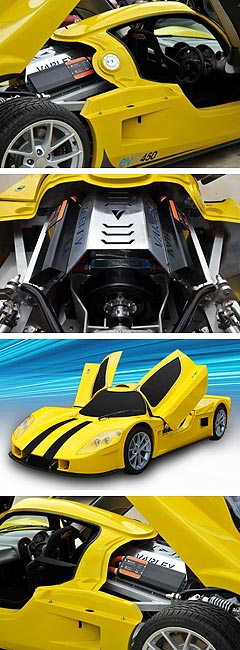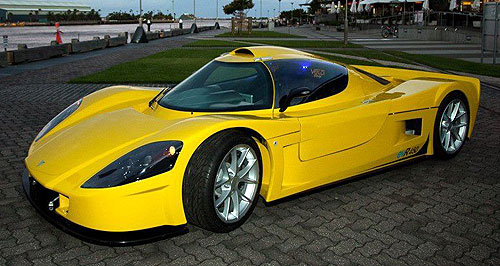Make / Model Search
Future models - Varley - evRVarley launches Aussie super-EVElectri-coupe: Varley's evR-450 sprints to 100km/h in 3.8 seconds but produces no exhaust emissions. Full evR supercar details revealed as Varley launches its first of many Aussie EVs19 Dec 2011 A PORSCHE 911 Turbo-rivalling supercar that can hit 100km/h in 3.8 seconds but emits no exhaust gases has emerged as the first in a series of all-new electric vehicles from little-known Australian vehicle engineering firm Varley Group, which this month celebrated its 125th birthday. Designed and developed by the Newcastle company’s Brisbane-based EV division, Varley Electric Vehicles, the scissor-doored zero-emissions super-coupe was revealed in final production guise for the first time earlier this month at Varley’s 125-year anniversary celebration. The release of full specifications follows the ground-breaking new model’s public debut in conjunction with the Australia Electric Vehicles Conference in Brisbane in October, and the first of two variants will open for orders in January. However, Varley Electric Vehicles says the evS-450, which is expected to be priced from under $200,000 and will be joined on sale by the higher-performance evR-450 later next year, represents the first in a range of locally engineered EVs from the company. “We’ve started with the showy one first,” the manager of Varley’s electric vehicle division, John Bettini, told GoAuto. “But we are developing other electric vehicles. “Varley recognises the market potential for electric vehicles in Australia and globally and we are investing heavily in the technology. “We have a long-standing history of making specialty vehicles for a range of clients and today marks our entry into the mainstream market with this new, high-performance technology. “We aim to provide our customers, now and in future, with world-class EV capabilities and products. The evR-450 is our first example of this.” Varley Group produces a range of specialty vehicles for military, industrial and tourism purposes – including the conversion of Mercedes-Benz G-class models for the Australian Defence Force - but Mr Bettini said demand from armed forces for electric vehicles would lead to a range of Varley-built EVs for both military and civilian use. “Our main market is the military and EVs are a core part of our business,” he said. “The military has expressed interest in hybrid and eventually all-electric vehicles. I can’t say too much about it, but they could be in the sky, in the water or on the ground, so watch this space.” Mr Bettini indicated that at least some of those vehicles would not be just be applicable to the military, but would not elaborate.  For now, Varley has released full details of the evS-450, which goes on sale next month at a price that is yet to be announced, and the evR-450 flagship, which will be released following final validation and compliance testing. For now, Varley has released full details of the evS-450, which goes on sale next month at a price that is yet to be announced, and the evR-450 flagship, which will be released following final validation and compliance testing.Mr Bettini said the first publicly available Varley EV has already attracted more than six potential buyers globally, but was unable to say if the evS/evR would be a sell-out in Australia, where Varley’s status as a low-volume vehicle manufacturer allows it to sell just 25 examples a year, because no firm deposits have yet been taken. “We’ve had a number of expressions from interest from all over the world, which is very positive,” he said. “There’s been a flood, but we’re not yet in a position to put pen to paper.” Varley’s inaugural EV is powered by a completely Australian-made electric drive system, comprising a liquid-cooled 24kWh lithium-ion battery pack that powers a pair of patented mid-mounted three-phase Carbon ironless core AC electric motors. The latter were designed specifically for this application by Queensland-based company Ultramotive Technologies, which is now owned by Varley as part of its mission to “become the world’s premier maker of AC motors”. However, while the two-seater evS-450 is fitted with a 300-amp ‘Wavesculptor’ motor controller supplied by another Queensland-based company Tritium, the top-shelf evR-450 gets a more powerful 350-amp controller. The result is peak power of some 280kW at 2550rpm and a sledgehammer-like 1050Nm of torque (0-2550rpm) for the evS-450, while the evR-450 slams down no less than 310kW (at 2420rpm) and a Bugatti Veyron-rivalling 1225Nm (0-2420rpm). Varley says that is enough to accelerate the more luxury-oriented evS-450, which still weighs just 1290kg, to 100km/h in 4.6 seconds and a top speed of 160km/h, while the 40kg-lighter (1250kg) evR-450 can sprint to 100km/h in just 3.8 seconds on its way to a 180km/h top speed. In other words, the evR-450 will be as rapid as Tesla’s pioneering electric sportscar, the Lotus Elise-based S Roadster. It also means the evR-450 will be almost as quick (but not as fast) as many of the world’s most powerful conventional supercars, including the 911 Turbo, Nissan GT-R, Mercedes SLS AMG, Audi R8, Jaguar XKR-S, BMW’s upcoming M6 and the finest from Ferrari and Lamborghini. Both supercars will offer a maximum driving range of up to 160km and take eight hours to recharge from a standard 15-amp household power outlet. Varley said it will consider fast-charging capabilities for its future products. While a number of electric vehicles have been converted from existing models like the Mazda2 and Hyundai Getz in Australia, the Tesla Roadster was Australia’s first ‘factory’ EV and Mitsubishi’s i-MiEV was the nation’s first mass-production EV. However, although another Australian firm has promised to deliver an electric sportscar by early 2013 (this time priced from under $100,000) the Varley supercar should become Australia’s first locally produced EV - and first homegrown e-sportscar – even before Nissan’s battery-electric Leaf and Holden’s Volt plug-in hybrid go on sale here next year. Mr Bettini said the Varley EV’s electric motors, which use proprietary ‘Dynamic Overspeed’ technology to allow greater motor flexibility and performance, were custom-designed by Ultramotive, while Tritium’s Wavesculptor inverters are capable of up to 96 per cent peak efficiency, making it one of the most efficient electric drivelines in the world. “Varley was impressed to learn that some of the best electric vehicle technologists are developing products in our own backyard,” he said. “We decided that we could leverage that innovation to compliment the high-quality, high-volume engineering and manufacturing capabilities at Varley to cultivate a new market for electric vehicles in Australia.” Varley’s hand-built electric super-coupe – which measures 4267mm long, 1880mm wide, just 1092mm high and rides on a 2667mm wheelbase - is based around a tig-welded semi-monocoque aluminium chassis and fibreglass body built to its own specifications and supplied by Michigan-based Superlite Cars. However, Mr Bettini said 100 per cent of evS/evR would soon take place in Australia following a deal to produce those components locally. Both models feature a six-point seamless race-spec roll cage, CNC billet aluminium suspension with adjustable coil-over-shocks and four-piston Brembo brakes with 355mm front and 365mm rear discs. Wheel sizes are 18x9.5-inch front and 10x12-inch rear with 275/35 ZR18 front and 325/30 ZR19 rear tyres, while the evS-450 rides on multi-spoke aluminium wheels and the evR-450 gains lightweight rotary-forged aluminium wheels and a slightly firmer suspension set-up. Inside both scissor-door Varley supercars is a minimalist, driver-focused cockpit with an iPhone/iPad-integrated vehicle control interface and DigiDash 2 Pro instrument cluster, while the evS will be fitted with more luxury items, including the option of leather trim. “We wanted to give our customers the option of a sport version as not everyone is comfortable with a race-spec car for day-to-day driving. We’re excited that we can start taking orders for the evS in January next year,” said Mr Bettini. “We have developed a unique design that is not only functional and scalable, but will create excitement and passion in true car enthusiasts. We think our entry into the sportscar market captures the spirit of the traditional supercar, but using highly efficient and zero-emission Australian technology.”  Read moreAll future modelsMotor industry news |
Click to shareVarley modelsAll future modelsMotor industry news |



 Alfa Romeo
Alfa Romeo Abarth
Abarth Audi
Audi Aston Martin
Aston Martin BMW
BMW Bentley
Bentley Ferrari
Ferrari Chevrolet
Chevrolet Ford
Ford Fiat
Fiat GWM
GWM Foton
Foton Hyundai
Hyundai Honda
Honda Jaguar
Jaguar Isuzu
Isuzu Kia
Kia Jeep
Jeep Land Rover
Land Rover Lamborghini
Lamborghini Maserati
Maserati Lexus
Lexus McLaren
McLaren Mazda
Mazda Mercedes-Benz
Mercedes-Benz Mitsubishi
Mitsubishi Mini
Mini Peugeot
Peugeot Nissan
Nissan Ram
Ram Porsche
Porsche Rolls-Royce
Rolls-Royce Smart
Smart Skoda
Skoda Suzuki
Suzuki Subaru
Subaru Toyota
Toyota Tesla
Tesla Volvo
Volvo Zeekr
Zeekr







Facebook Twitter Instagram